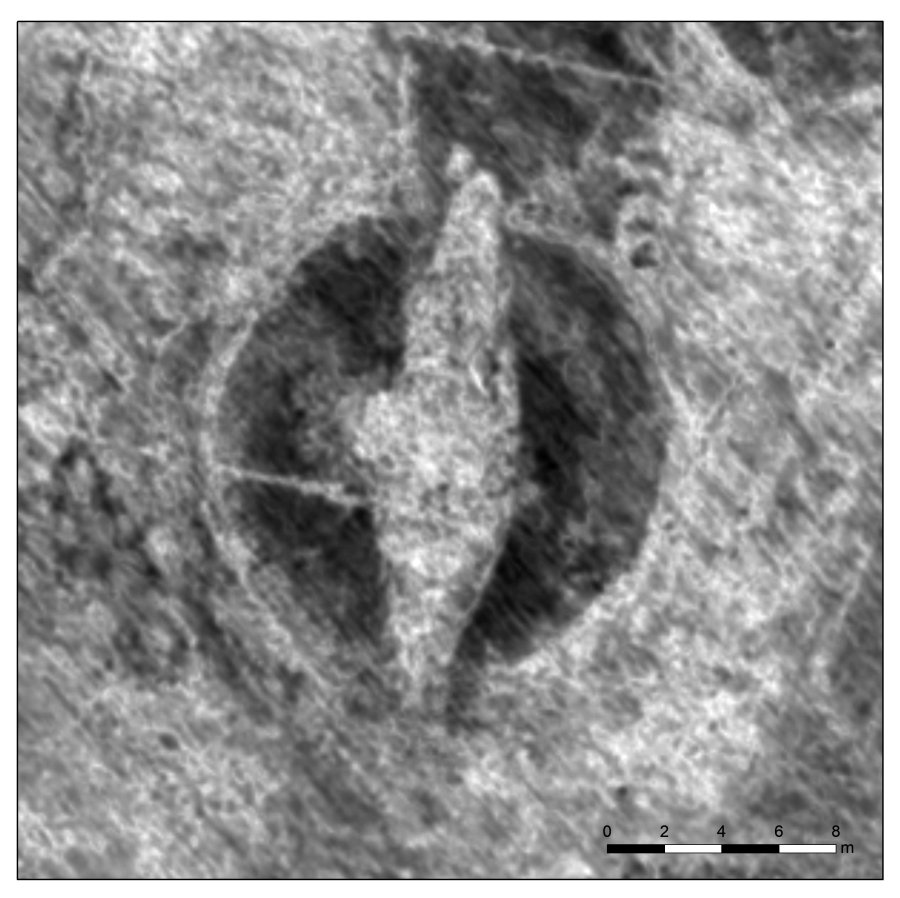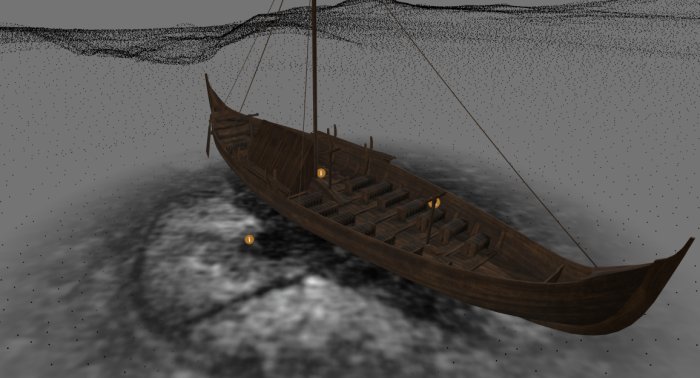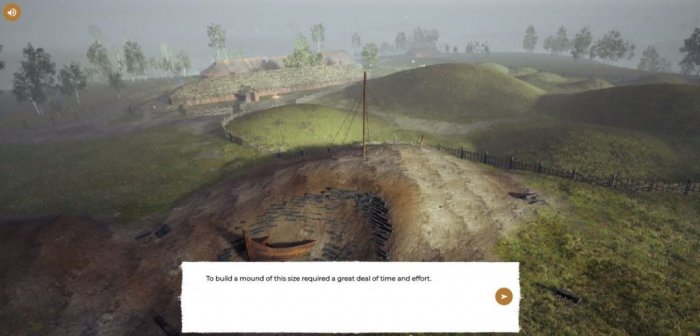Explore The Giant Gjellestad Viking Ship Burial In This Stunning Virtual Tour
Jan Bartek - AncientPages.com - Modern technology gives us a superb opportunity to look through the eyes of ancient people.
Virtual tours like this one can take us on a wonderful journey back in time, and anyone interested in archaeology and ancient history cannot resist seeing how people lived thousands of years ago. The Vikings are long gone, but even they would be impressed with the 3-D reconstruction of their settlements, burial mounds, and huge majestic ships.
The reconstruction of the Gjellestad Viking ship burial site. Credit: Gjellestadstory.no
In 2018 archaeologists made an incredible discovery in Norway. Using high-resolution georadar scientists unearthed a giant Vikings ship along with a Medieval settlement and three burial mounds.
Archaeologists made the discoveries from the Norwegian Institute for Cultural Heritage Research (NIKU) with technology developed by the Ludwig Boltzmann Institute for Archaeological Prospection and Virtual Archaeology (LBI ArchPro).
“We are certain that there is a ship there, but how much is preserved is hard to say before further investigation”, Morten Hanisch, county conservator in Østfold said at the time of the discovery. Today we know with certainty a giant Viking ship was unearthed at the site..
This was a unique archaeological discovery because Viking ship burials are rare. By modern standards, it might sound crude, but Viking burials were intended to be a spectacular ritual. Viking funeral traditions involved burning ships and complex ancient rituals. Based on discovered archaeological evidence it seems that the funeral boat or wagon was a practice reserved for the wealthy.
So far scientists have unearthed only three well-preserved Viking ship burials in ships in Norway and seven in entire Europe. The discovery made in Østfold was called sensational, and with good reason. Archaeologists found traces of at least eight so far unknown burial mounds destroyed by ploughing. The georadar data also revealed 5 longhouses - some of them remarkably large.
Ten small research teams excavated the sites for about two weeks. Today, we can learn more about this incredible discovery.
Reconstruction of the Gjellestad Viking ship. Credit: Gjellestadstory.no
Earlier this year, scientists could confirm this was with certainty a Viking ship that most likely dates from the transition to the Viking Age, which is generally considered to have started with the attack on Lindisfarne in the late 8th century.
Unfortunately, experts also noticed the ship suffered substantial damage from fungi, so the Directorate for Cultural Heritage recommended excavating the ship.
The Gjellestad Viking ship is huge, measuring nearly 20 meters, and yet, it’s smaller and narrower than the Oseberg ship and or Gokstad ship.
A beautiful virtual reconstruction of the site has now been made available by the Norwegian website Gjellestad Story.
As explained on the site, “the burial site at Gjellestad and the obliterated burial mounds tell a story about a power struggle for control and three significant changes of authority in the area. Victors have laid claim to the area by burying their dead partially on top, or within, the preceding burials of the defeated.”
The virtual tour lets you see burial mounds and visit longhouses. Credit: Gjellestadstory.no
Preserving our archaeological sites means preserving our ancient legacy. While going on this fascinating virtual journey, you also have the chance to enter the longhouses and see what life was like during the Viking Age.
A typical Viking home was a longhouse (langhús), usually 5 to 7 meters wide (16 to 23 feet). Wealthy Vikings could live in very large longhouses that could be from 15 to 75 meters long (50 to 250 feet). Inside the longhouses were several rooms, divided by walls and sometimes a large and imposing hearth, with stones set on end in the earth, mirroring the shape of the longhouse. Ventilation and illumination were provided through smoke holes in the roof.
You may not know it, but Vikings used to burn and bury their longhouses. After a longhouse had burned to the ground, one or more burial mounds were placed on top of its remains.
You can access the magnificent virtual tour of Gjellestad Viking Ship Burial site here.
Written by Jan Bartek - AncientPages.com Staff Writer
More From Ancient Pages
-
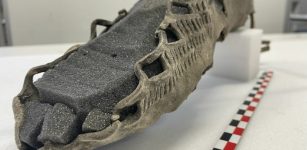 Startling Roman-Looking Sandal Discovered Buried Deep Beneath The Snow In Norwegian Mountains
Archaeology | Apr 13, 2022
Startling Roman-Looking Sandal Discovered Buried Deep Beneath The Snow In Norwegian Mountains
Archaeology | Apr 13, 2022 -
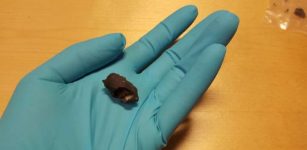 Oldest Scandinavian DNA Found In Ancient Chewing Gum
Archaeology | May 15, 2019
Oldest Scandinavian DNA Found In Ancient Chewing Gum
Archaeology | May 15, 2019 -
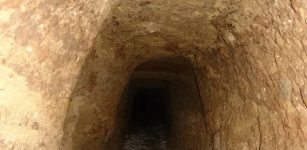 Huge 40-Meter Long 16th Century Tunnel For Looting Was Exposed Inside Tower Tomb
Archaeology | Jul 15, 2019
Huge 40-Meter Long 16th Century Tunnel For Looting Was Exposed Inside Tower Tomb
Archaeology | Jul 15, 2019 -
 Mahabharata And Ramayana – Two Major Sanskrit Epics Of Ancient India
Featured Stories | Jul 12, 2021
Mahabharata And Ramayana – Two Major Sanskrit Epics Of Ancient India
Featured Stories | Jul 12, 2021 -
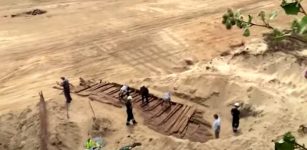 Remains Of A Roman Ship Discovered In Serbia
Archaeology | Aug 7, 2023
Remains Of A Roman Ship Discovered In Serbia
Archaeology | Aug 7, 2023 -
 Hairy Snail Discovered In 99-Million-Year-Old Amber
Archaeology | Oct 29, 2022
Hairy Snail Discovered In 99-Million-Year-Old Amber
Archaeology | Oct 29, 2022 -
 Mysterious Melchizedek: ‘King Of Righteousness’ And Heavenly High Priest In Bible And Dead Sea Scrolls
Biblical Mysteries | Sep 2, 2017
Mysterious Melchizedek: ‘King Of Righteousness’ And Heavenly High Priest In Bible And Dead Sea Scrolls
Biblical Mysteries | Sep 2, 2017 -
 Large Statue Of Ancient Guardian Discovered At Angkor Wat
Archaeology | Aug 7, 2017
Large Statue Of Ancient Guardian Discovered At Angkor Wat
Archaeology | Aug 7, 2017 -
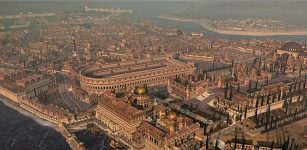 Why Was Constantinople Called New Rome?
Ancient History Facts | Mar 9, 2020
Why Was Constantinople Called New Rome?
Ancient History Facts | Mar 9, 2020 -
 Were Medieval Philosophers Familiar With The Multiverse Theory?
Featured Stories | Oct 4, 2018
Were Medieval Philosophers Familiar With The Multiverse Theory?
Featured Stories | Oct 4, 2018 -
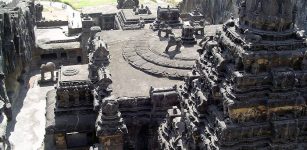 Cannabis Protected India’s Famous Ellora Caves From Decay For 1,500 Years
Archaeology | Mar 12, 2016
Cannabis Protected India’s Famous Ellora Caves From Decay For 1,500 Years
Archaeology | Mar 12, 2016 -
 Unearthing Vadnagar And The Search For Hueng Tsang’s 10 Monasteries
Archaeology | Dec 11, 2015
Unearthing Vadnagar And The Search For Hueng Tsang’s 10 Monasteries
Archaeology | Dec 11, 2015 -
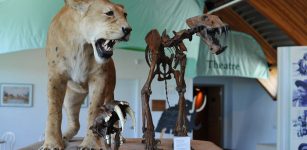 Remains Of Ancient Predators Shed Light On How Humans Did Or Didn’t Find Food
Archaeology | May 2, 2022
Remains Of Ancient Predators Shed Light On How Humans Did Or Didn’t Find Food
Archaeology | May 2, 2022 -
 Why Winter Solstice Matters Around The World
Archaeoastronomy | Dec 20, 2022
Why Winter Solstice Matters Around The World
Archaeoastronomy | Dec 20, 2022 -
 On This Day In History: Germany Invades Poland – On Sep 1, 1939
News | Sep 1, 2016
On This Day In History: Germany Invades Poland – On Sep 1, 1939
News | Sep 1, 2016 -
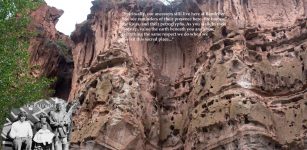 Bandelier National Monument: Unusual Ancient Ruins Of Pueblo People In The Southwest
Civilizations | Jun 30, 2016
Bandelier National Monument: Unusual Ancient Ruins Of Pueblo People In The Southwest
Civilizations | Jun 30, 2016 -
 ‘Joyeuse’ – Legendary Sword With Relics Of Saints Was A Private Treasure Of Emperor Charlemagne
Artifacts | Dec 24, 2021
‘Joyeuse’ – Legendary Sword With Relics Of Saints Was A Private Treasure Of Emperor Charlemagne
Artifacts | Dec 24, 2021 -
 Mysterious Disappearance Of Louis Le Prince – Murder And Cover-Up?
Featured Stories | Jun 27, 2020
Mysterious Disappearance Of Louis Le Prince – Murder And Cover-Up?
Featured Stories | Jun 27, 2020 -
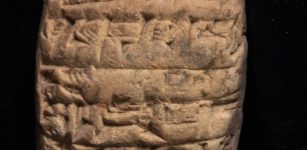 Lost City Of Irisagrig Comes To Life In Ancient Stolen Tablets
Archaeology | Jun 5, 2018
Lost City Of Irisagrig Comes To Life In Ancient Stolen Tablets
Archaeology | Jun 5, 2018 -
 Strange Reports Of A Mysterious Stone-Throwing Phenomenon And Invisible Entity Encountered Worldwide
Featured Stories | Dec 4, 2023
Strange Reports Of A Mysterious Stone-Throwing Phenomenon And Invisible Entity Encountered Worldwide
Featured Stories | Dec 4, 2023


